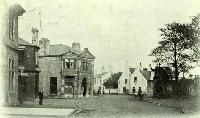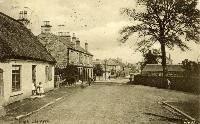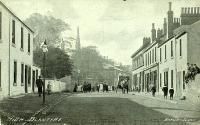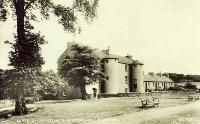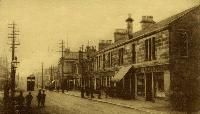Ordnance Gazetteer of Scotland, Francis H Groome 1885
Blantyre, a parish of north-west Lanarkshire, containing the villages of Blantyre, Blantyre works, Auchinraith, Auchentibber, Barnhill, and Stonefield Blantyre village, called also High Blantyre or Kirkton of Blantyre, stands near the right bank of the Rotten Calder, 3 miles W by N of Hamilton and 8 1/4 SE of Glasgow. It has the Post Office under the latter, with money order and savings bank departments, and the station (High Blantyre) on the Strathaven branch of the Caledonian. Population (1831) 255, (1871) 393, (1881) 701.
Blantyre works, or Low Blantyre, lies 1 3/4 miles to the N E on the left bank of the Clyde, opposite Bothwell, with which it is connected by a fine suspension bridge, and near Blantyre station (with a Post Office under Glasgow) on the Clydesdale section of the Caledonian. Founded in 1785, it is neatly built; and at it are the dying works of Messrs Monteith & Co, and a weaving factory, where the great African traveller and missionary, David Livingstone (1803 – 73), worked in his boyhood as a “piecer”. In Blantyre he was born; and within a short distance of his birthplace it is proposed to (1881) to build, at the cost of £4,000, a memorial UP Church, in the tower of which his statue will be placed. Population (1835) 1821, (1871) 1304, (1881) 1029.
Auchinraith, Auchentibber, Barnhill, and Stonefield are respectively 3 furlongs E by N, 1 1/2 mile SSW, 1/1 mile N by E, and 1 3/8 mile NE, of High Blantyre; and had a population (1881) of 684, 435, 183, and 3235. Bounded NE by Bothwell, SE by Hamilton and Glassford, W by East Kilbride, Cambuslang and Old Monkland, the parish has an extreme length from N by E to S by W of 6 1/1 miles, a breadth from E to W of from 3 furlongs to 2 miles, and an area of 4027 acres of which 73 are water.
A mineral spring at Park , strongly impregnated with sulphur held in solution by hydrogen, was much frequented by Glasgow families toward the middle of last century, and still is famed in scrofulous and scorbutic cases. The soils are various, deep peat moss in the extreme SW, and elsewhere ranging through fertile kinds of sand, loam, and clay. Great improvements have been wrought by draining and by the adoption of best methods of culture, and barely 500 acres are waste or pastoral. A water supply was introduced (1880-81) at the cost of £10,000. At Calderside near Auchentibber, is the camp Knowe, a conical hillock 200 yards in circumference, and anciently girt by a ditch; but the most interesting relic of antiquity is the tottering fragment – 2 gables and a vault – of Blantyre Priory, founded for Austen canons before 1296 by Alexander II. Built of red sandstone, and perched on the a wooded crag, nine furlongs down the Clyde from Blantyre Works, it stands right opposite Bothwell Castle, whence the view of it is thus described in Dorothy Wordsworths Journal (ed. By Princ. Shairp, 1874), p50:- ‘On the opposite bank, which is finely wooded with elms and other trees, and the remains of an ancient priory built upon a rock; and rock and ruin are so blended together that it is impossible to separate the one from the other. Nothing can be more beautiful than the little remnants of this holy place; elm trees – for which we were near enough to distinguish them by their branches – grow out of the walls, and overshadow a small but very elegant window. It can scarcely be conceived what a grace the castle and priory impart to each other; and the river Clyde flows on smooth and unruffled below, seeming to my thoughts more in harmony with the sober and stately images of former times, than if it had roared over a rocky channel, forcing its sound upon the ear” Of course there is ( at least in Scottish Chiefs)a subterranean and subsqueous passage leading from the castle to the priory, and through the window in the latter Wallace is said to have sprung over the precipice, eluding thus a body of English pursuers. Walter Stuart, commendator of this priory in 1580, was created Lord Blantyre in the peerage of Scotland in 1606, having 8 years earlier purchased the Barony of Blantyre, which was all feued out in small parcels, still held under his present descendant, Charles Stuart, 12th baron Blantyre, of Erskine House and Lennoxlove. Two proprietors hold each an annual value of £500 and upwards, 23 of between £100 and £500, 18 of from £50 to £100 and 27 from £20 to £50. In the presbytery of Hamilton and synod of Glasgow and Ayr, its ministers income amounting to £307, Blantyre has a handsome parish church (rebuilt 1863; 900 sittings) and another church at Stonefield (1880; 1000 sittings) as well as a Free Church, a UP Church, an Evangelical Union Church, and St Joseph’s RC church (1878; 620 sittings). The public schools of High and Low Blantyre and Auchintibber RC school with respective accommodation for 400, 400 and 527 children had (1879) an average attendance of 383, 314 and 274 (plus 137 evening scholars) and grants of £335 2s 6d, £225 18s, and £224 6s (plus £65 15s 6d). Valuation (1881) £38,081 5s. Population (1801) 1751, (1821) 2630, (1841) 3047, (1851) 2848 (1861) 3092, (1871) 3472, (1881) 9760.Calderside, a property on the western border of Blantyre parish, Lanarkshire. Coal has been worked here on a small scale; a silicified tree is near, rising out of the bed of the Rotten Calder; and there is also here a curious conical hillock, the Campknowe, anciently fortified by the Caledonians.Craighead, an estate, with a mansion, in Blantyre parish, Lanarkshire, on the left bank of the Clyde, 1 mile S of Bothwell village.Stonefield, a thriving seat of industry and population in Blantyre parish, Lanarkshire, 2 1/2 miles NW of Hamilton and 8 1/4 SE of Glasgow, under which it has a post office. Its Established chapel of ease was founded in 1878, and contains 900 sittings. Pop. (1871) 395, (1881) 4511, of whom 2164 were in Stonefield proper, 331 in Baird’s Rows, 1321 in Dixon’s Rows, and 695 in Springwell.—Ord. Sur., sh. 23, 1865.A topographical dictionary of Scotland, Samuel Lewis, 1846Auchinraith, a hamlet, in the parish of Blantyre, Middle ward of the county of Lanark; containing 77 inhabitants. It lies to the east of, and is a short distance from, the village of Blantyre; the Alston family have a handsome seat here.Auchintiber, a hamlet, in the parish of Blantyre, Middle ward of the county of Lanark; containing 73 inhabitants. It is situated in the western part of the parish, on which side the Rotten-Calder water forms the boundary, and separates the parish from that of Kilbride.Barnhill, a village, in the parish of Blantyre, Middle ward of the county of Lanark, 1/2 a mile (N) from Blantyre; containing 165 inhabitants. It is near the eastern boundary of Cambuslang parish.Blantyre, a parish, in the Middle ward of the county of Lanark; including the villages of Auchinraith, Auchintiber, Barnhill, Blantyre, Blantyre-Works, Hunthill, and Stonefield; and containing 3047 inhabitants, of whom 1464 are in the village of Blantyre-Works, and 264 in that of Blantyre, or Kirkton, 3 miles (NW) from Hamilton, and 8 1/4 (SSE) from Glasgow. The lands formerly belonged to the Dunbars, of Enteckin, in which family they remained till the Reformation, when they were purchased by Walter Stewart, son of Lord Minto, treasurer of Scotland, upon whom, on the suppression of monastic establishments, the ancient priory of this place was bestowed by James VI, who also created him Lord Blantyre. The priory is said to have been founded by Alexander II, as a cell to the abbey of Jedburgh, or, according to Spottiswoode, of Holyrood House; and Walter, who was prior at that time, was one of the commissioners appointed to negotiate for the ransom of David Bruce, the Scottish king, who had been made prisoner by the English, in the battle of Durham, in 1346. The remains of the priory, which are very inconsiderable, are situated on the summit of a high rock on the bank of the river Clyde, opposite to the ruins of Bothwell Castle; and little more than one of the vaults, which is still entire, with two gables, and a portion of the outer walls, is remaining. The buildings were of red granite; and the ruins form, in combination with the castle, an interesting feature in the scenery.The parish extends for six miles in length, from north to south, and varies greatly in breadth, not averaging more than one mile in the whole; it comprises 4170 acres, of which, excepting 200 acres of moss land and plantations, all is arable. The principal rivers are the Clyde, which enters the parish at a short distance below Bothwell bridge, and forms a boundary between this place and the parish of Bothwell for about three miles, flowing majestically between lofty banks richly clothed with wood; and the Calder, which enters the parish near Rottenburn, and, after forming several picturesque falls, in its course along the western boundary, flows into the Clyde near Daldowie. The tributary streams are, the Redburn, which has its source in the lands of Park farm, and joins the Clyde near Bothwell bridge; and two other rivulets, one rising in the lands of Shott, and one at Newmain, which also fall into the river Clyde. Salmon are taken in abundance near the mill-dam of Blantyre. The scenery is, in many parts, exceedingly beautiful; the parish is generally well wooded, and diversified with gently undulating eminences and fertile dales. The soil is various, being in some parts a fine rich loam, in others a strong clay, and in others sand, with some portions of moss; the system of agriculture is improved, and good crops of various kinds of grain are raised. Great improvement has been made in draining the lands, and a considerable tract called Blantyre moor, formerly a common, has been subdivided, and brought into cultivation; the farm houses and buildings are of superior order. The rateable annual value of the parish is £8280. Peat for fuel is cut on Edge Moss, and coal, of which the veins are but very thin, is worked at Calderside and Rottenburn; limestone of a quality well adapted for building, and for agricultural purposes, is wrought in the southern part of the parish. Ironstone, also, is abundant, and at Black-Craig, on the borders of the parish, not less than seventeen different seams are seen, superincumbent on each other; the ironstone is worked in the parish of Kilbride, where are the openings of the mines, but the strata lie principally in this parish.The principal village is situated on an eminence over-looking the river Clyde, and in the midst of a beautiful country, embellished with timber of venerable and stately growth. It appears to have attained its present importance and extent, from the introduction of the cotton manufacture by Messrs. Dale and Monteith, who, in 1785, erected a mill for the spinning of cotton-yarn, and, in the year 1791, another for the making of mule twist. In 1813, Messrs. Monteith and Company erected a weaving factory, in which the number of looms has, since that time, increased from 450 to nearly 600; and around these works, giving profitable employment to a large number of the population, the present village has been erected. In the two spinning-mills, which are both worked by water power, are 30,000 spindles, affording occupation to about 500 persons; and in the weaving establishment, the works of which are driven partly by water power, and partly by steam, are 600 power-looms, in the management of which more than 300 persons are regularly employed. In connexion with these works, is an establishment for dyeing cotton-yarn with the Turkey red. The total number of persons employed in all the departments, is nearly 1000, of whom more than 500 are females; the houses in the village are comfortable and neatly built, and it is watched and cleansed by persons paid by the company, who have also built a public washing-house, and appropriated a large bleach green, on the banks of the Clyde, for the use of the inhabitants, who are supplied with hard and soft water, for domestic use, by force-pumps at the factory. A library has been for some years established, which contains an extensive collection of useful volumes.The parish is in the presbytery of Hamilton and synod of Glasgow and Ayr; the minister’s stipend is about £184, with a manse, and a glebe valued at £16 per annum. The parish church, which is not in good repair, was erected in 1793, and will only hold about 300 persons. There is a chapel at the Blantyre Mills, erected by the company for the accommodation of the work-people employed there, and containing sittings for 400 persons; the minister’s stipend is paid, one-half by the proprietors of the works, and the other half from the seat-rents. A place of worship has been erected for members of the Free Church. The parochial school affords a liberal education; the salary of the master is £26, with £19 fees. There is also a school for the children of the workpeople at the mills, to which purpose the chapel is applied, during the week; the master is appointed by the company, who give him a house and garden rent free, and a salary of £20. Ancient urns have been, at various times, discovered in several parts of the parish; some of these were inclosed in a kind of kistvaen, covered by heaps of loose stones, and contained ashes, with remnants of half-burnt bones scattered round them. Within the last few years, a stone coffin was discovered, containing an urn of baked earth, in which was a skull with the teeth nearly entire and in good preservation; and fragments of six larger, and more richly ornamented, urns were found in another part of the same field, which is now called “Archers Croft.” Stone coffins have also been found at Lawhill and Greenhall, and other places situated within the limits of the parish. At Calderside, is a large hill called the Camp-Know, of conical form, 600 feet in circumference at the base, and surrounded by a moat; and near it is a kind of subterraneous cavern of flags. At Park farm is a fine spring, which has long been in high repute for the cure of scorbutic affections and diseases of the eye; it is strongly impregnated with sulphur, combined with muriate and sulphate of lime, and was formerly much resorted to by numerous invalids from Glasgow and its neighbourhood. There are also various mineral springs on the banks of the river Calder. The late John Miller, Esq., professor of law in the university of Glasgow, resided for some years at Milheugh, in the parish, and was buried in the churchyardHunthill, a hamlet, in the parish of Blantyre, Middle ward of the county of Lanark, 3 1/2 miles (WNW) from Hamilton; containing 60 inhabitants. It is situated on the western borders of the parish, and nearly adjoins the village of Blantyre, in the manufactures and works connected with which the population is partly engaged.Stonefield, a village, in the parish of Blantyre, Middle ward of the county of Lanark, 1¼ mile (NE by E) from the village of Blantyre; containing 174 inhabitants. It lies in the north-eastern part of the parish, and on the west bank of the Clyde, which here separates the parish from that of Bothwell. The population of the village is chiefly employed in the manufactures of the district, and a few in common handicraft trades.January 1874High Blantyre – Latest from the Pit – A very amusing incident occurred here the other night. About ten o’clock a carriage and pair drew up at a small public house in the village. The proprietrix hastened out to attend on her illustrious visitors, when, to her great astonishment, whom should she see seated in the machine, but two “knights of the pit” as they had left their work, in full uniform, even to the bright and shining lamps on their foreheads. They entered the inn, and after partaking of some brandy drove off to their respective abodes evidently greatly pleased with the sensation they had created. [Hamilton Advertiser 3 January 1874]
|
|
|
|
|

